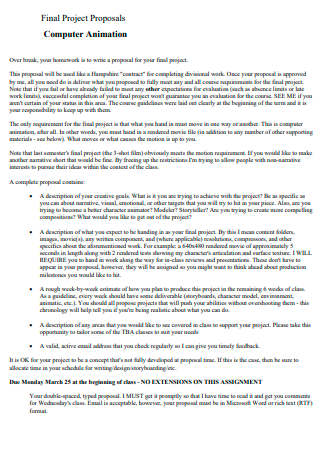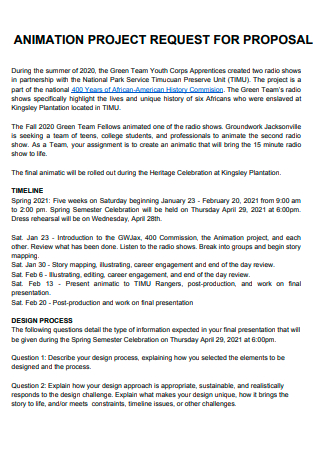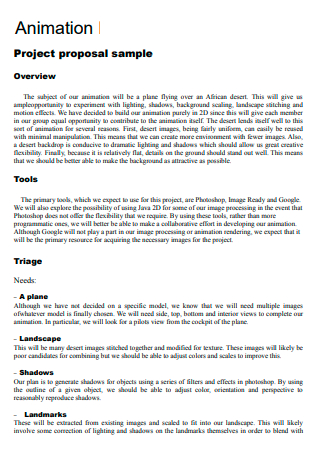3+ Sample Animation Project Proposal
FREE Animation Project Proposal s to Download
3+ Sample Animation Project Proposal
What Is an Animation Project Proposal?
Tips for Writing an Animation Project Proposal
How to Write an Animation Project Proposal
Different Types of Animation Styles
FAQs
What is a multimedia project?
What are the benefits of using animation?
Why is animation so important?
What Is an Animation Project Proposal?
The skill of animating inanimate objects is known as animation. Animation is a creative drive that precedes cinema for a long time. You should have enough depth to address all of the points without overwhelming the reader. Consider this a synopsis of the work you want to accomplish, as well as a synopsis of what you have already discussed with the client. It should have a neat and professional layout. The majority of the material was most likely provided throughout the sales process prior to delivering the Animation Proposal, so this may just be a one-sheet review and reminder. Best case scenario: the customer sees this proposal and is desperate for the job. Be sure to review the animation project proposal example as it can act as a reference for when you are writing your own.
Tips for Writing an Animation Project Proposal
In a project proposal, you provide a solution to a problem that your potential customer has identified, as well as the project’s budget, preferred Schedule, and other pertinent details. After numerous talks with your client, you and your client will generally agree on and sign a project proposal for animation. When you already have a concept for how to start a project, creating an animation proposal may seem superfluous and difficult; nonetheless, it will act as a guide and give structure while you work on it. You must make your project proposal stand out while drafting it. Include everything your customer wants to know about their film, as well as information they didn’t realize they wanted.
How to Write an Animation Project Proposal
You now have a better idea of what to put in a proposal. There are a few options that you can go about writing it. You can either start from scratch and write it yourself or download a template, which this article provides for you. You can do everything yourself: design the layout, write all the copy, and add the photos. This is ideal for those who want to personalize their proposals and include their twist. Creating your own proposal might help you stand out. However, make sure you know what potential clients want in terms of proposal formatting and text. The second alternative is to use a template that you may get on the internet. This will save you time and give you an idea of how to organize all of the material you will need for your proposal. Simply input or copy and paste your unique information into the template, then save it. There are available design proposal template free that you can use and compare, to find one that suits your needs.
Step 1: Write an introduction
Also can be associated with an Executive Summary, your animation project proposal should open up with a formal introduction. This can set up the document for what the rest of the contents will contain as well as inform the client of your intentions for the project.
Step 2: State your animation objectives
Define the goal of your animation project proposal. Your major goal in terms of marketing will be to attract new clients or consumers. It’s possible, though, that you’d like to begin a fresh campaign for existing clients or even rekindle their interest in you. Explainer or instructive videos, on the other hand, can be seen in a somewhat different light because they are more complicated and lengthier in duration. It is conceivable that your goal here is to present the instructions as simply and succinctly as possible without having the movie too long or boring. Your animation must be distinctive and interesting, regardless of its objective.
Step 3: Create a project schedule
Make a list of the project tasks, together with Time Tracking or estimate for each. The task breakdown will help you appropriately assign your team, and you may use a chart to clearly describe the resources, tasks, and timeframe in this area.
Step 4: Budget and timescale
If you have a deadline for your animation or film, scheduling should be at the top of your list of priorities. Your production firm will want to know how much you are willing to invest in terms of money. When planning conversations begin, you should have a clear concept of your budget since neither party wants to squander money or offer something you can’t afford. Keep in touch with your producer as often as possible. They will require information once you have submitted your animation project proposal, so make a timetable to communicate with them so you are both on the same page. There may be things you wish to alter, so give yourself plenty of time.
Step 5: Prepare a portfolio
Your client may request to see your previous works or check the experience you have under your belt. Make sure your portfolio contains sample works from previous projects and you can share your demo reel with them. This allows you to show your skillset and hook your client, persuading them to go through with your animation project proposal.
Step 6: Conclude your proposal
Give a quick recap of all of the major issues raised throughout the proposal. Because this is the final part, it is also your last chance to persuade your stakeholders; thus, emphasize your solution and why your stakeholders should care about it while ensuring that your recommended technique is in the organization’s best interests.
Different Types of Animation Styles
Animated videos are an excellent method to interact with viewers in an effective and memorable way. They may be used to make product demos, instructional videos, and more. You may produce unique and interesting material to share with your target audience by collaborating with a professional animation company or an experienced freelancer. Choosing a style is one of the most crucial phases in the animation production process. Various animation techniques communicate various tones and are best suited for various objectives. Here’s a brief rundown of some of the most popular animation styles to help you understand your possibilities.
FAQs
What is a multimedia project?
Audio, video, images, text for voiceovers, and on-screen titles are all common components of a multimedia project. A sketch of the visual components, the voiceover or title text, and any production comments are all included in the storyboard panel of a scene. Be sure to check out the available template for Multimedia Proposals when you need to write one.
What are the benefits of using animation?
Using animation, viewers may learn about real-life events that they can encounter in their daily lives. Viewing, doing, and coaching are all included in this learning technique. This aids in the development of practical skills and the retention of knowledge. Learning becomes more enjoyable when animation is used, and it encourages people to seek out more material to learn.
Why is animation so important?
Animation is significant because it allows us to create tales and express emotions and ideas in a unique, simple-to-understand manner that both little children and adults can comprehend. Animation has helped to link people all around the world in ways that writing and live-action films haven’t always been able to. Be sure to check out the Production Proposal template to see the difference.
One might not see the purpose of a project proposal right away, but in the long run, you will be thankful for preparing one for your animation. Not only will it help you remain organized in terms of your skill set and thoughts on the project, but it can also showcase how determined and professional you are in handling clients. So what are you waiting for, start writing your animation project proposal and wow your clients!




